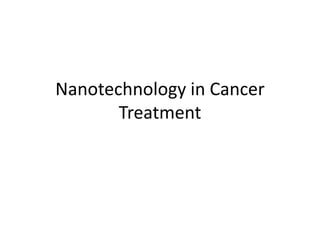
5cancer
- 1. Nanotechnology in Cancer Treatment
- 2. Background and Introduction Cancer Development of abnormal cells that divide uncontrollably which have the ability to infiltrate and destroy normal body tissue Chemotherapy Use of anti-cancer (cytotoxic) drugs to destroy cancer cells. Work by disrupting the growth of cancer cells Nonspecificity Toxicity Adverse side effects Poor solubility
- 3. Cancer Nanotechnology interdisciplinary research, cutting across the disciplines of Biology Chemistry Engineering Physics Medicine Nanoparticles Semiconductor quantum dots (QDs) Ion oxide nanocrystals Carbon nanotubes Polymeric nanoparticles Liposomes Unique Properties Structural Optical Magnetic
- 4. • Tumors generally can’t grow beyond 2 mm in size without becoming angiogenic (attracting new capillaries) because difficulty in obtaining oxygen and nutrients. • Tumors produce angiogenic factors to form new capillary structures. • Tumors also need to recruit macromolecules from the blood stream to form a new extracellular matrix. • Permeability-enhancing factors such as VEGF (vascular endothelial growth factor) are secreted to increase the permeability of the tumor blood vessels.
- 5. Tissue selectivity Tissues with a leaky endothelial wall contribute to a significant uptake of NP. In liver, spleen and bone marrow, NP uptake is also due to the macrophages residing in the tissues.
- 7. • In tumors the uptake depends on the so-called enhanced permeability and retention effect (EPR).
- 9. Schematic of EPR (enhanced permeability and retention) effect in solid tumors: 1- nanovehicles passively target to vasculature and extravasate through fenestrated tumor vasculature. 2- the extended circulation time (stealth features) allows accumulation in tumor tissue 3- lack of lymphatic drainage prevents removal of nanoparticles after extravasation This passive targeting process facilitates tumor tissue binding, followed by drug release for cell killing. Nanovehicles which fail to bind to tumor cells will reside in the extracellular (interstitial) space, where they eventually become destabilized because of enzymatic and phagocytic attack. This results in extracellular drug release for eventual diffusion to nearby tumor cells and bystander cell.
- 12. In vivo distribution of long-circulating radiolabeled liposomes i.v. injected into C26 tumour-bearing mice Liposomes : DPPC ( a saturated lipid)/ 20%GM1 ganglioside ( a stealth Glycolipid)
- 15. Vascular targets Vascular endothelial GF Vascular cell adhesion molecule Matrix metalloproteinases Tumour targets Human epidermal receptor Transferrin receptor Folate receptor
- 16. Affinity-based targeting of tumors. Ruoslahti E et al. J Cell Biol doi:10.1083/jcb.200910104 © 2010 Ruoslahti et al.
- 17. Saturation of receptors affects the specificity of targeting. Ruoslahti E et al. J Cell Biol doi:10.1083/jcb.200910104 © 2010 Ruoslahti et al.
- 18. Treating tumors with cooperative nanoparticles. Ruoslahti E et al. J Cell Biol doi:10.1083/jcb.200910104 © 2010 Ruoslahti et al.
- 19. Molecular Cancer Imaging (QDs) Tumor Targeting and Imaging Emission wavelengths are size tunable (2 nm-7 nm) 4 High molar extinction coefficients Conjugation with copolymer improves size-tunable optical properties of ZnS-capped CdSe QDs biocompatibility, selectivity and decrease cellular toxicity 5
- 20. Correlated Optical and X-Ray Imaging High resolution sensitivity in detection of small tumors 6 x-rays provides detailed anatomical locations Polymer-encapsulated QDs No chemical or enzymatic degradations QDs cleared from the body by slow filtration or excretion out of the body
- 21. ANTICANCER DRUG •Passive diffusion •Poorly vascolarized tumor PHYSIOLOGICAL BARRIERS •EPR non cellular based mechanisms region •Acidic enviroments in tumors DRUG DRUG RESISTANCE •Biochemical alterations cellular based mechanisms •Endocytosis/phagocytosis by the cells •Overcome MDR DISTRIBUTION, CLEARANCE OF •Large volume of DRUG distribution •Toxic side-effects on normal cells Controlled tumoral interstitial drug release
- 22. TUMOR-TISSUE TARGETING Conventional Nanoparticles Long-circulating Nanoparticles • Size > 100 nm. • Size < 100 nm, “Stealth”, invisible to • Delivery to RES tissues. macrophages. • Rapid effect (0.5-3 hr). • Hydrophylic surface to reduce opsonization (e.g. PEG) • For RES localized tumors (hepatocarcinoma, hepatic • Prolonged half-life in blood compartment. metastasis, non-small cell lung • Selective extravasation in pathological cancer, small cell lung site. cancer, myeloma, lymphoma). • For tumors located outside the RES regions. • Gradually absorbed by lymphatic system.
- 23. TUMOR-CELL TARGETING MDR Reversion A) Free doxorubicin enters into the tumor cells by diffusion but is effluxed by Pgp, resulting in the absence of therapeutic efficacy. B) Doxorubicin-loaded NPs adhere at the tumor cell membrane where they release their drug content, resulting in microconcentration gradient of doxorubicin at the cell membrane, which could saturate Pgp and reverse MDR Brigger et al., 2002
- 24. V di uscita V di del farmaco(Attività Pgp) ingresso farmaco Conc intracellulare farmaco Diff di conc farmaco esterno/interno
- 25. Zhang et al., 2008
- 26. Caelyx® is a form of doxorubicin| that is enclosed in liposomes. It is sometimes known as pegylated doxorubicin hydrochloride (PLDH). It is used to treat: •Advanced ovarian cancer that has come back after being treated with a platinum-based chemotherapy drug. •Women with advanced breast cancer who have an increased risk of heart damage from other chemotherapy drugs. • Aids-related Kaposi’s sarcoma . Myocet® , another form of liposomal doxorubicin, is used to treat advanced (metastatic) breast cancer| in combination with another chemotherapy drug, cyclophosphamide| .
- 27. Alexis et al., 2009
- 28. Target: enzimi del rilassamento di DNA Inibitori delle topoisomerasi Doxorubicina • Induce complesso ternario DNA-farmaco-Topoisomerasi (filamenti di DNA rotti legati in 5’ a una tirosina dell’enzima) • Danneggia il filamento formando radicali liberi-
- 32. Target: microtubuli Antimitotici inibizione di assemblaggio stabilizzazione polimeri. Microtubuli: polimeri di tubulina: crescita richiede GTP alle estremita’ e sui monomeri. Idrolisi di GTP a GDP disassembla microtubulo. Per la stabilità servono MAP
